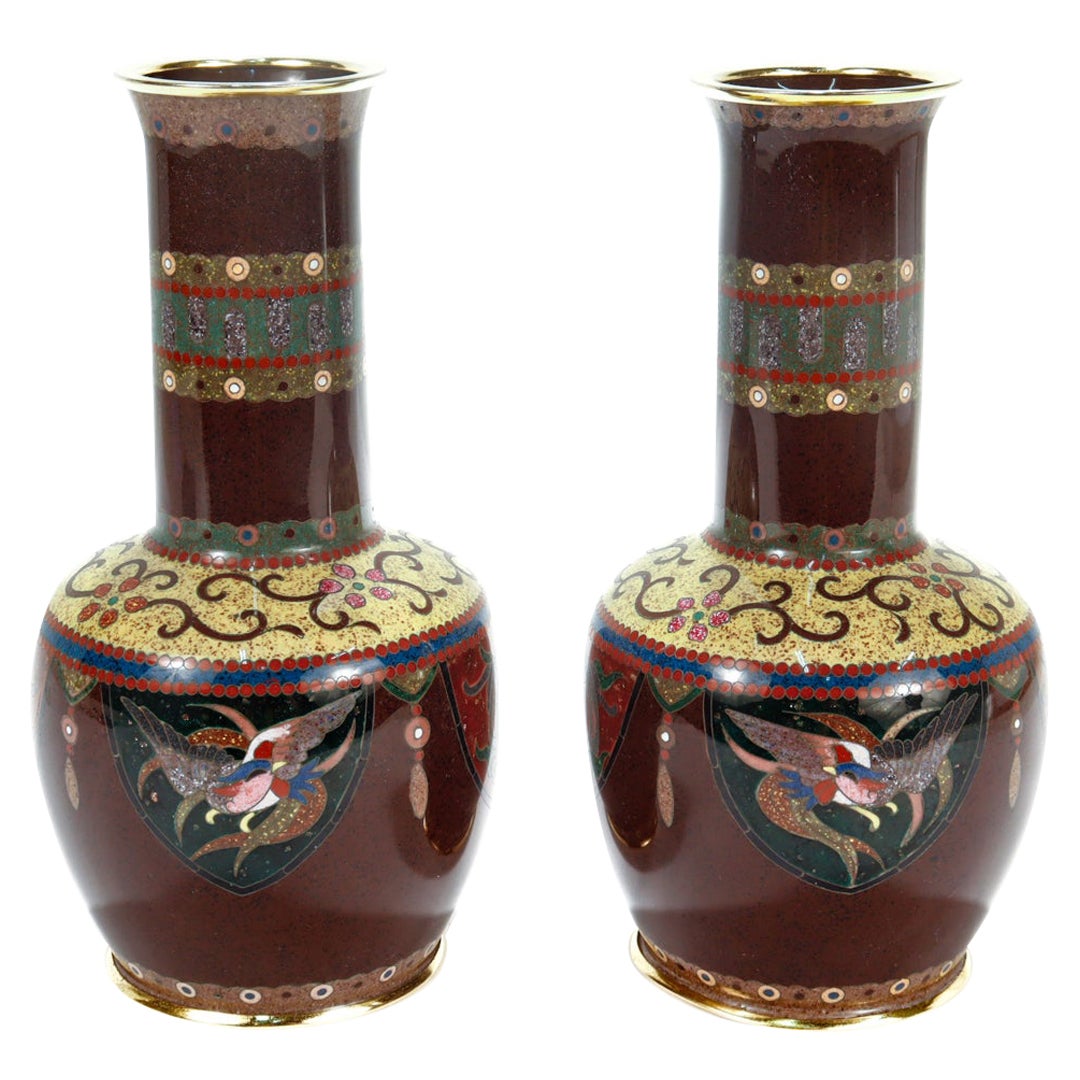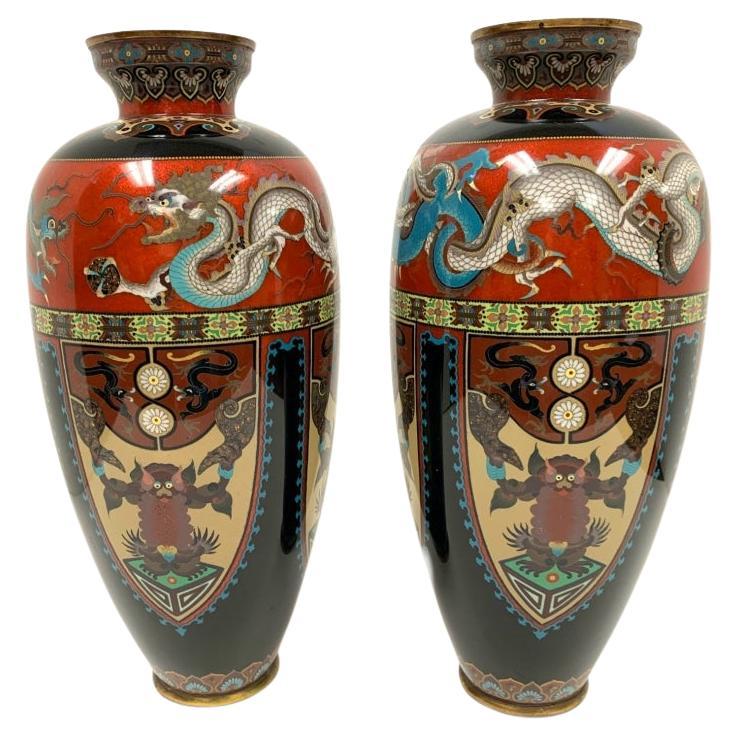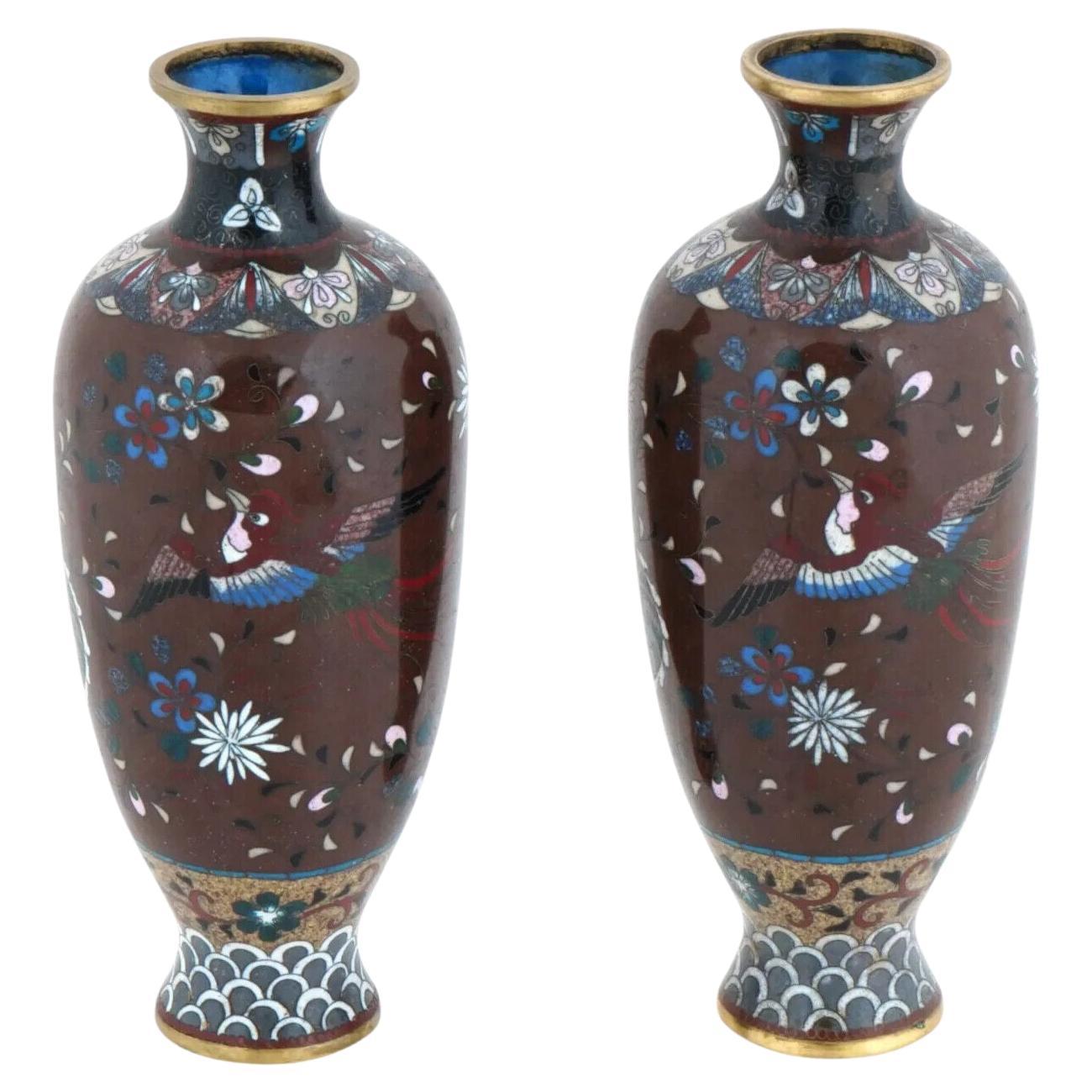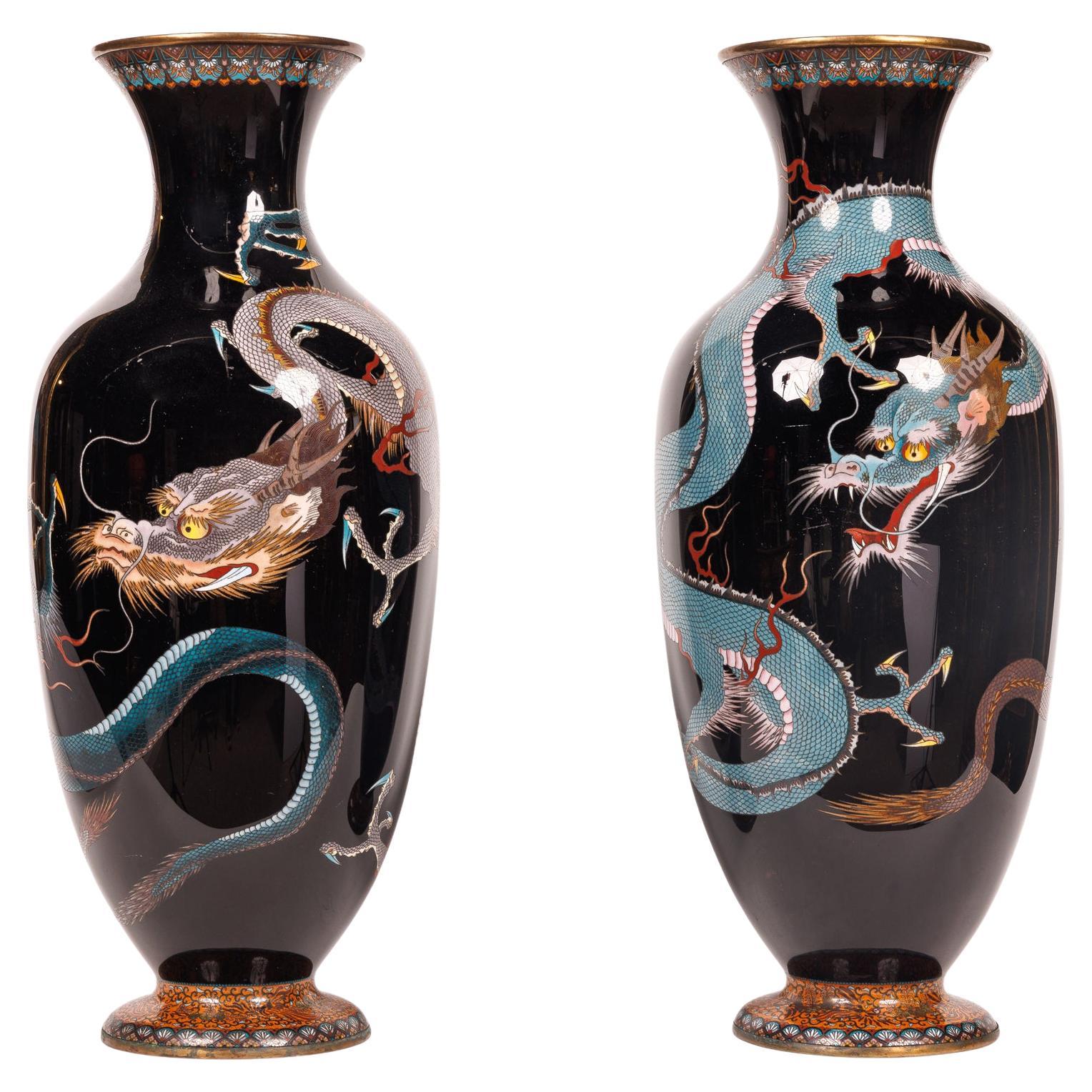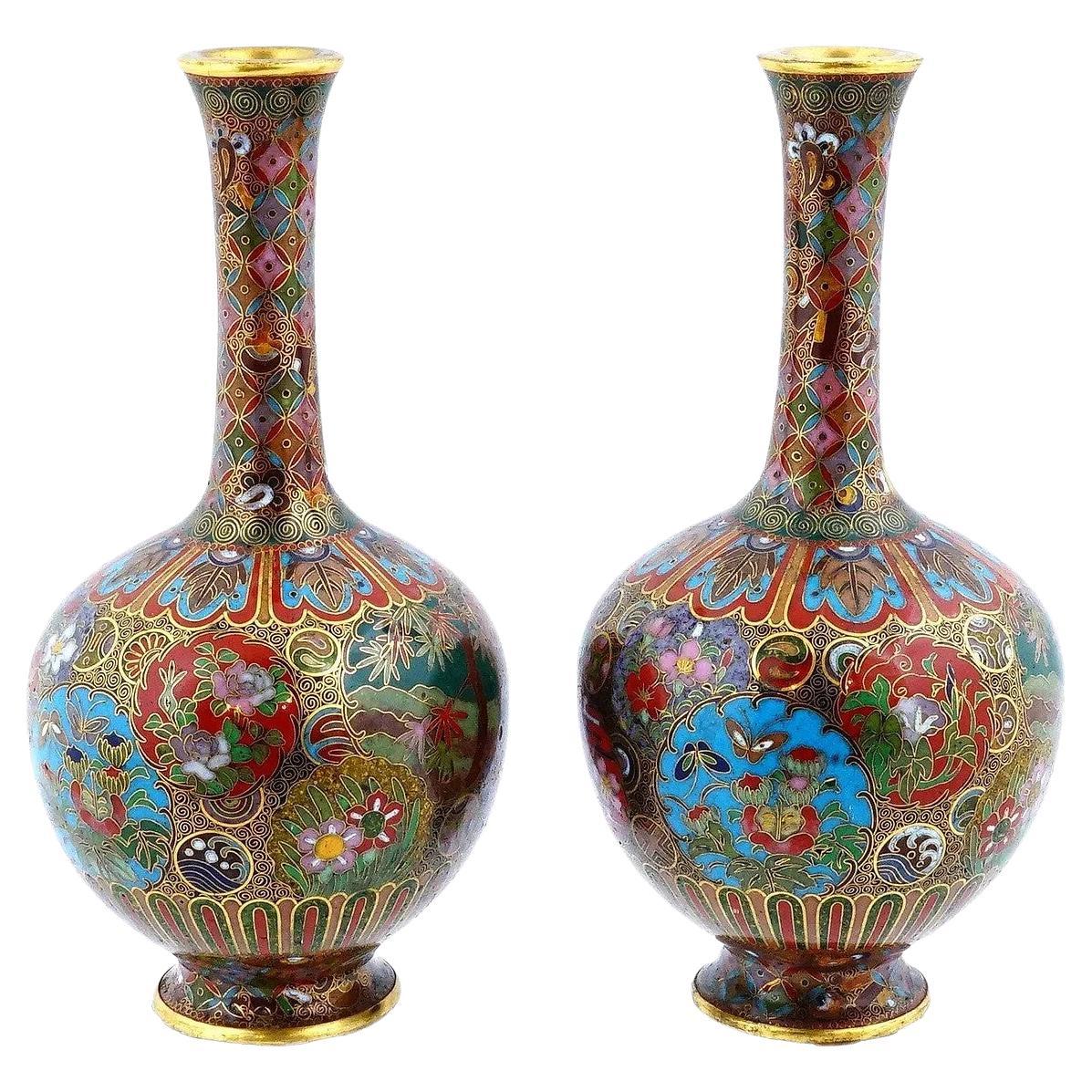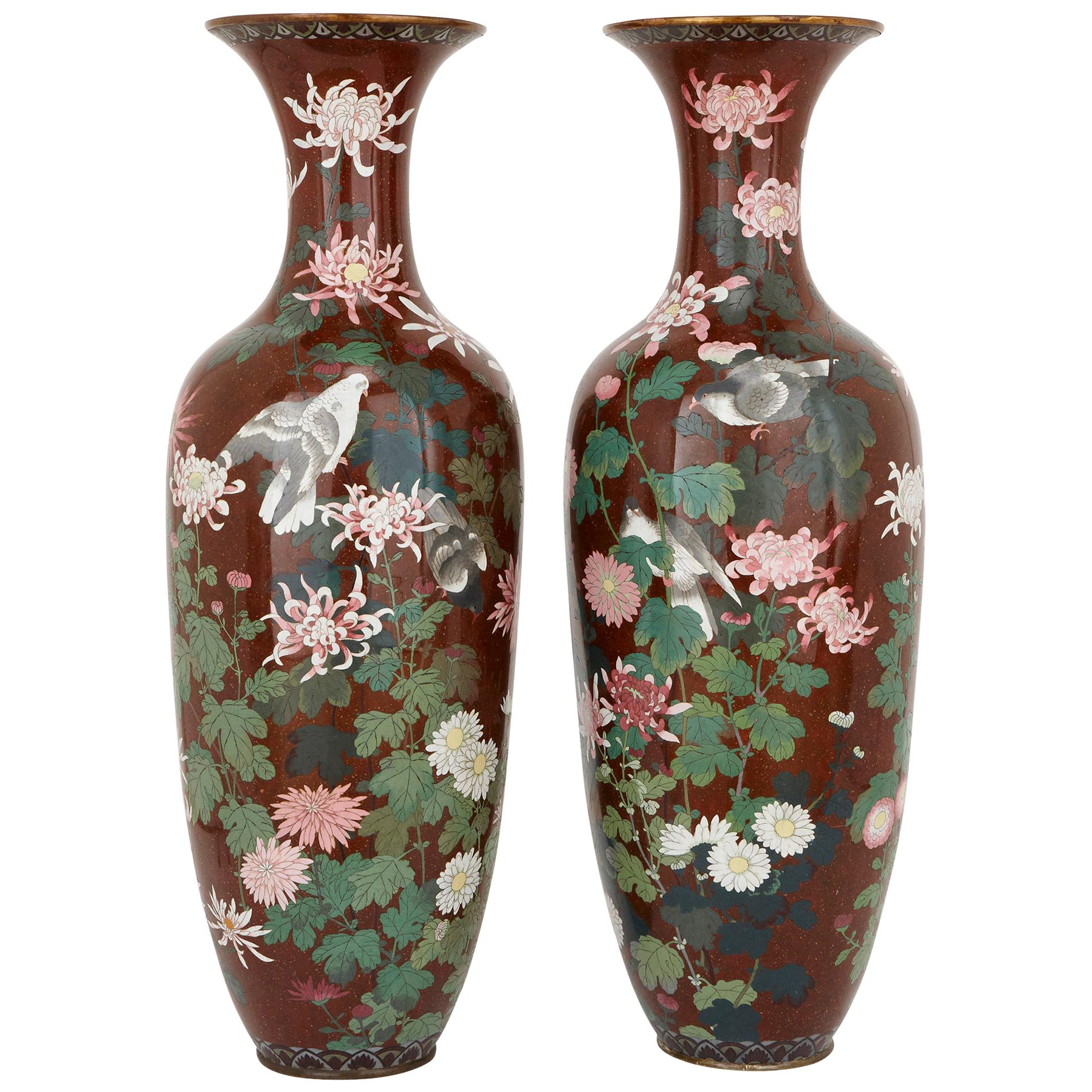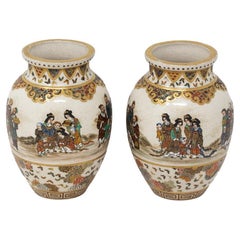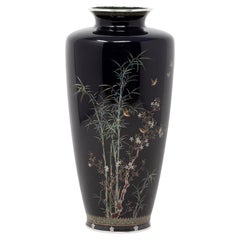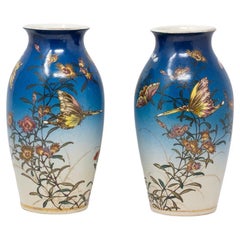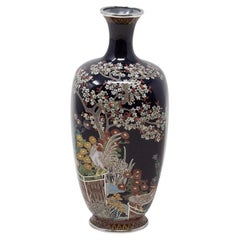Items Similar to Antique Japanese Cloisonne Enamel Vase Pair Hayashi School
Want more images or videos?
Request additional images or videos from the seller
1 of 21
Antique Japanese Cloisonne Enamel Vase Pair Hayashi School
$8,221
£6,000
€6,998.68
CA$11,260.71
A$12,524.37
CHF 6,539.84
MX$152,408.29
NOK 83,523.71
SEK 78,330.51
DKK 52,233.81
Shipping
Retrieving quote...The 1stDibs Promise:
Authenticity Guarantee,
Money-Back Guarantee,
24-Hour Cancellation
About the Item
Meiji Period (1868-1912)
From our Japanese collection, we are delighted to offer this pair of Antique Japanese Cloisonne Enamel Vases by the Hayashi School in their Original Tomobako. The vases beautifully shaped with waisted hexagonal bodies, tapered necks and rounded top rims decorated upon a dark blue almost black glaze with opposing dragons. The dragons finely worked in varying gauge silver wire with visible scales and long tendrils coming from the nose. The pair enamelled with various colours really elevating the three dimensional look across the body of the vase. One vase bares the original sales label to the side while the bases are stamped with the makers mark for Hayashi School and the original cataloguing number sticker on one vase. Both vases are finished with silvered rims. The vases are accompanied by the original silk lined Tomobako with a single partition and cushioned interior for housing the vases. The exterior of the box is signed 七宝家 林製 (shippo studio, Hayashi made) with the Takahara & Co retailers logo showing that the vases were made in the Hayashi school and then retailed through Takahara & Co. The Vases date to the Meiji Period (1868-1912) circa 1900.
Takahara & Co were located in Kyoto and a known manufacturer and retailer of shippo-yaki (cloisonne). There company mark contains two mountains crossing over which looks like a stylised capital M.
Hayashi Kodenji was a student to Hayashi Shogoro (1835-1896) who played a pivotal role in training students in the art of cloisonne was a central figure in the cloisonné enamel industry well into the 20th century. Kodenji was the founder and head of the Shipo-cho enamelers guild and in 1894 he opened a school to train cloisonne workers that operated until 1907. He ran a showroom in Nagoya from 1907-1914 and also operated a sales branch in London. As a master of cloisonne wears he went on to win medals at expositions in Nuremberg 1885, Chicago 1893, Paris 1889 and St. Louis 1904 and finally a price at the Liege in 1905. He was awarded the Medal of the Green Ribbon in Japan (Ryokujuhosho) in 1902. Kodenji I went onto produce cloisonne wears with his son Suguemon (1859-1922) known as Kodenji II with virtually no easy distinction between either maker. They were both followed by Hayashi Tomijiro, Kodenji III (1879-1944) and Kurakichi Kodenji IV, (1904-1982).
Cloisonne is a technique of decorating metalwork objects with coloured material separated by wire often made from precious metals. In the first instance the decoration is formed by creating a stencil on the metal object by affixing wires to the surface which will be visible once the product is finished allowing the artisan to craft beautiful scenes such as blossoming flowers or mythical animals by filling in the spaces with various colours.
Enamel (vitreous enamel) also known as porcelain enamel, is a material made by fusing powdered glass to a substrate by firing, usually between 750 and 850 °C. The powder melts, flows, and then hardens to a smooth, durable vitreous coating. The word vitreous comes from the Latin vitreus, meaning “glassy”.
Meiji Period was an era of Japanese history that spanned from 1868 to 1912. It was the first half of the Empire of Japan, when the Japanese people began to build a paradigm of a modern, industrialised nation state and emergent great power, influenced by Western countries and aesthetics. As a result of radically different ideas, the changes to Japan were profound and it affected the social structure, politics, economy, military, and foreign relations across the board. The period corresponded to the reign of Emperor Meiji and was preceded by the Keio era and was succeeded by the Taisho era.
Cultural Art during the Meiji Period was of particular interest to the government and they overhauled the art export market which in turn promoted Japanese arts via various world’s fairs, beginning in Vienna at the world fair in 1873. The government heavily funded the fairs and took an active role organising how Japan’s culture was presented to the world including creating a semi-public company named Kiritsu Kosho Kaisha (First Industrial Manufacturing Company). The Kiritsu Kosho Kaisha was used to promote and commercialise exports of Japanese art and established the Hakurankai Jimukyoku (Exhibition Bureau) to maintain quality standards. For the 1876 Centennial International Exhibition in Philadelphia, the Japanese government created a Centennial Office and sent a special envoy to secure space for the 30,000 items that would be displayed. The Imperial Household also took an active interest in arts and crafts, commissioning works by select artists to be given as gifts for foreign dignitaries further emphasising the high quality and importance of Japanese art. Just before the end of the 19th century in 1890, the Teishitsu Gigeiin (Artist to the Imperial Household) system was created to recognise distinguished artists. These artists were selected for their exceptionally high quality wares and talent in their own industry. Over a period of 54 years Seventy artists were appointed, amongst these were ceramicist Makuzu Kozan and cloisonné enamel artist Namikawa Yasuyuki.
Antique a collectable object such as a piece of furniture or work of art that has a high value because of its age and quality. Objects of this nature are generally considered antique at 100 plus years of age.
Measurements (centimetres) 15.3cm High x 5.5cm Diameter
- Dimensions:Height: 6 in (15.24 cm)Diameter: 2.17 in (5.52 cm)
- Style:Meiji (Of the Period)
- Materials and Techniques:
- Place of Origin:
- Period:1900-1909
- Date of Manufacture:1900
- Condition:Wear consistent with age and use.
- Seller Location:Newark, GB
- Reference Number:Seller: WBWDDD1stDibs: LU6971239088352
About the Seller
5.0
Gold Seller
Premium sellers maintaining a 4.3+ rating and 24-hour response times
Established in 2019
1stDibs seller since 2022
36 sales on 1stDibs
Typical response time: 3 hours
- ShippingRetrieving quote...Shipping from: Newark, United Kingdom
- Return Policy
Authenticity Guarantee
In the unlikely event there’s an issue with an item’s authenticity, contact us within 1 year for a full refund. DetailsMoney-Back Guarantee
If your item is not as described, is damaged in transit, or does not arrive, contact us within 7 days for a full refund. Details24-Hour Cancellation
You have a 24-hour grace period in which to reconsider your purchase, with no questions asked.Vetted Professional Sellers
Our world-class sellers must adhere to strict standards for service and quality, maintaining the integrity of our listings.Price-Match Guarantee
If you find that a seller listed the same item for a lower price elsewhere, we’ll match it.Trusted Global Delivery
Our best-in-class carrier network provides specialized shipping options worldwide, including custom delivery.More From This Seller
View AllJapanese Antique Meiji Period Satsuma Vase Pair Hand Painted by Gyokuzan
Located in Newark, England
Painted with Continuous Scenes
From our Japanese collection, we are delighted to offer this Japanese Satsuma Vase Pair by Gyokuzan. The Satsuma vase pair of squat bulbous form with ...
Category
Antique Late 19th Century Japanese Meiji Ceramics
Materials
Ceramic, Pottery
Japanese Antique Cloisonne Enamel Vase Hayashi Kodenji
Located in Newark, England
MEIJI PERIOD (1868-1912)
From our Japanese collection, we are delighted to introduce this good size Japanese Cloisonne Enamel Vase. The Vase of gently tapered form with a pinched n...
Category
Antique Early 1900s Japanese Meiji Metalwork
Materials
Gold, Silver, Enamel
Unusual Pair of Japanese Meiji Period (1868-1912) Satsuma Vases by Kinkozan
By Kinkozan
Located in Newark, England
Taizan Yohei IX Style
From our Japanese collection we are delighted to offer this pair of Japanese Satsuma Vases by Kinkozan. The Satsuma Vases of baluster shape made from earthenwa...
Category
Antique Early 1900s Japanese Meiji Ceramics
Materials
Ceramic, Earthenware, Pottery
Japanese Meiji Period Cloisonne Enamel Vase by Ando Jubei
By Ando Jubei
Located in Newark, England
Free international shipping
Ando Cloisonne Company Mark
From our Japanese collection, we are delighted to introduce this Japanese Cloisonne Enamel Vase by Ando Jubei. The Cloisonn...
Category
Antique Early 1900s Japanese Meiji Metalwork
Materials
Enamel, Wire
Japanese Pair of Large Antique Meiji Period Bronze and Mixed Metal Vases
Located in Newark, England
Inlaid with Gold and Silver
From our Japanese collection, we are thrilled to offer a Japanese Pair of Meiji Period Bronze Vases. The Japanese Bronze Vases of elongated form each sur...
Category
Antique Late 19th Century Japanese Meiji Vases
Materials
Metal, Gold, Silver, Bronze
Japanese Tashio Period (1912-1926) Cloisonne Enamel Vase Ando Company
By Ando Jubei
Located in Newark, England
The vase of large globular form decorated with a fine pastel blue ground enamel base and striking blue tulips in bloom across the centre. The base signed to the centre with the Ando ...
Category
20th Century Japanese Meiji Vases
Materials
Metal, Silver, Enamel, Metallic Thread
You May Also Like
Pair of Signed Antique Japanese Cloisonne Enamel Vases by Daikichi
By Ando Jubei, Kumeno Teitaro, Ando Shippo Ten
Located in Philadelphia, PA
A fine pair of Japanese Meiji period cloisonne enamel vases.
By the Ohta Cloisonne workshop of Aichi Prefecture, Japan. T...
Category
20th Century Japanese Meiji Metalwork
Materials
Enamel
Pair Of Japanese Meiji Era Cloisonne Vases
Located in Bridgeport, CT
Pair of Japanese cloisonné vases with fine traditional form decorated with dragons and demons, geometric motifs and floral bands.
Dimensions: 5" W x 12" H
Condition: Please see detai...
Category
Antique Late 19th Century Japanese Meiji Metalwork
Materials
Metal, Enamel
$1,400 / set
Antique Pair Of Meiji Japanese Cloisonne Enamel Vases
Located in Long Island City, NY
A pair of identical antique Japanese copper vases with cloisonne enamel design. Late Meiji period, before 1912. Elongated baluster shape with pronounced neck. Floral ornament with bl...
Category
Antique Late 19th Century Japanese Meiji Metalwork
Materials
Enamel, Copper
Large Pair of Meiji Period Japanese Cloisonne Enamel Double Dragon Vases
Located in Queens, NY
A large pair of Meiji Period Japanese Cloisonne Enamel Double Dragon Vases, 19th century.
Japanese cloisonne enamel dragon vases are highly ...
Category
Antique 19th Century Japanese Meiji Metalwork
Materials
Copper, Enamel
Pair Of Meiji Japanese Cloisonne Enamel Vases Kyoto School
Located in Long Island City, NY
A pair of Japanese cloisonne enameled brass vases. They feature a narrow neck, rounded body, and are decorated with an intricate pattern of floral designs in various colors, and gilt...
Category
Antique Late 19th Century Japanese Vases
Materials
Brass, Enamel
Pair of Antique Meiji Period Japanese Cloisonne Enamel Vases
Located in London, GB
These beautiful Japanese vases were crafted during the Meiji period of the late 19th Century, which was referred to as the Golden Age of cloisonne enameling.
The vases are of elo...
Category
Antique Late 19th Century Japanese Meiji Vases
Materials
Enamel
More Ways To Browse
Arts And Crafts Enamel
Emperor Japan
Japanese Metal Flower
Pair Cloisonne
Japanese Silver And Enamel
Japanese Labels
Antique Metal Train
Japanese Cushion
Japanese Maker Marks
Cloisonne Green
Japanese Metal Box
Cloisonne Collection
Cloisonne Enamel Box
Imperial Glass Works
Metal Animal Head
Japanese Export Silver
Cloisonne Porcelain
Green Dragon Vase
